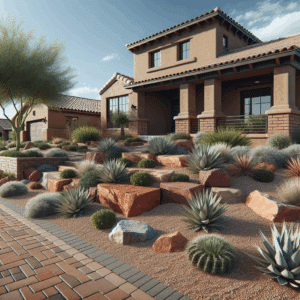As homeowners, we often face the challenge of keeping our landscapes vibrant and healthy throughout the year’s changing seasons. At Red Mountain Landscaping, we understand these challenges and are here to guide you with expert advice. Our comprehensive tips are designed for homeowners in Maricopa County, AZ, and will help you maintain a lush and appealing yard year-round.
Contents
- 1 Embrace the Early Spring Bloom
- 2 Maximize Your Summer Shade
- 3 Efficient Fall Cleanup
- 4 Winter Wonders: Preparing for Cold
- 5 The Importance of Soil Health
- 6 Pest and Disease Management
- 7 Enhancements with Native Plants
- 8 Water Conservation Techniques
- 9 Landscape Lighting for Safety and Ambience
- 10 Easy-to-Follow Seasonal Checklist
- 11 Conclusion
Embrace the Early Spring Bloom
When spring arrives, it’s the perfect time to assess your landscape. Begin by inspecting your plants and trees for any damage caused by winter weather. Prune any dead branches and clear debris to ensure healthy growth.
In addition to inspection, early spring is ideal for fertilization. Using a high-quality, slow-release fertilizer will give your plants the boost they need to flourish. This preparation not only enhances appearance but also strengthens root systems for the coming months.
Maximize Your Summer Shade
Summer can be harsh, with the sun blazing down on your precious plants. Ensure your landscape thrives by focusing on adequate watering. Early morning is the best time to water, minimizing evaporation while maximizing absorption.
Consider installing shade structures or planting trees to provide natural shelter. Native plants are particularly resilient and will offer better shade once mature, keeping both your plants and outdoor spaces cooler during the hottest days.
Efficient Fall Cleanup
As fall approaches, it’s crucial to prepare your landscape for cooler temperatures. Start by raking fallen leaves and removing any debris. This not only maintains aesthetic appeal but also prevents mold and disease.
Additionally, consider planting autumn perennials. These hardy plants can add pops of color and interest to your garden, providing a lively look even as temperatures drop.
Winter Wonders: Preparing for Cold
Winter preparation is key to a thriving landscape come spring. Begin by protecting sensitive plants with burlap wraps or frost cloths to shield them from freezing temperatures. Mulching around the base of plants can also guard roots against cold and moisture loss.
Don’t forget to prepare your irrigation system, either. Draining and shutting down systems prevents damage from freezing, ensuring everything will be operational again when spring returns.
The Importance of Soil Health
Healthy soil is the foundation of a flourishing landscape. Test your soil’s pH at least once a year to determine its acidity or alkalinity. This knowledge allows you to amend the soil with necessary nutrients for optimal plant growth.
Regular aeration can also benefit your soil, particularly in clay-heavy areas. Aerating loosens compacted soil, improves drainage, and increases oxygen flow to roots, making your plants more robust and healthier.
Pest and Disease Management
It’s important to remain vigilant about pests and diseases throughout the year. Regularly inspect plants for signs of infestation, such as holes in leaves or discolored patches. Early detection aids in managing issues promptly before they spread.
Natural pest control options, like introducing beneficial insects or using neem oil, can keep pests at bay without harming the environment. Swift action leads to healthier plants and a more vibrant landscape overall.
Enhancements with Native Plants
Incorporating native plants into your landscape is not only environmentally friendly but also practical. These plants are adapted to local conditions and require less water and maintenance, making them a sustainable choice for homeowners.
Native flora also attracts local wildlife such as birds and pollinators. This not only supports biodiversity but adds movement and life to your garden, creating a thriving ecosystem.
Water Conservation Techniques
Conserving water is crucial in maintaining a landscape both beautifully and sustainably. Implementing drip Irrigation Systems can significantly reduce water wastage by delivering moisture directly to the plant base.
Additionally, consider rain barrels for collecting rainwater throughout the year. These systems enable you to utilize naturally acquired water for irrigation, reducing dependency on municipal sources.
Landscape Lighting for Safety and Ambience
Lighting plays a dual role in landscapes: providing safety and enhancing ambience. Install pathway lighting to illuminate walkways, reducing the risk of trips and falls during nighttime.
Accent lighting can highlight key features of your yard, such as fountains or statues, creating a warm and inviting atmosphere for evening relaxation or entertaining.
Easy-to-Follow Seasonal Checklist
- Spring Inspection: Check for winter damage and begin fertilizing your plants to encourage growth.
- Summer Watering: Ensure you water early in the morning to reduce evaporation and enhance plant hydration.
- Fall Debris Removal: Regularly clear fallen leaves and debris to prevent mold and keep your yard tidy.
- Winter Protection: Shield sensitive plants with frost covers and manage irrigation systems to prevent freezing damage.
- Year-Round Vigilance: Always keep an eye on soil health, pest activity, and moisture levels to optimize landscape wellbeing.
Conclusion
With these seasonal Landscape Maintenance tips from Red Mountain Landscaping, you can enjoy a vibrant yard all year long. Contact Us at 480-373-9312 or Request a Free Quote to discover how we can assist your landscaping needs.




